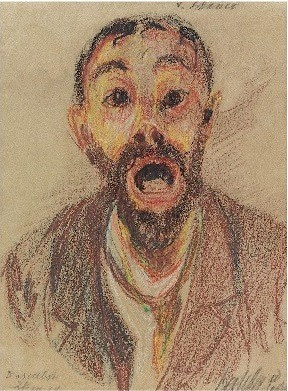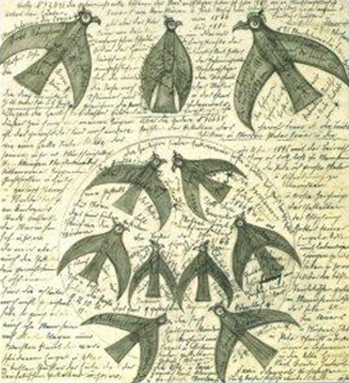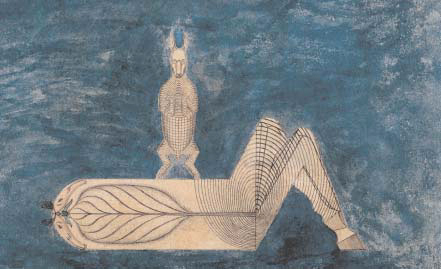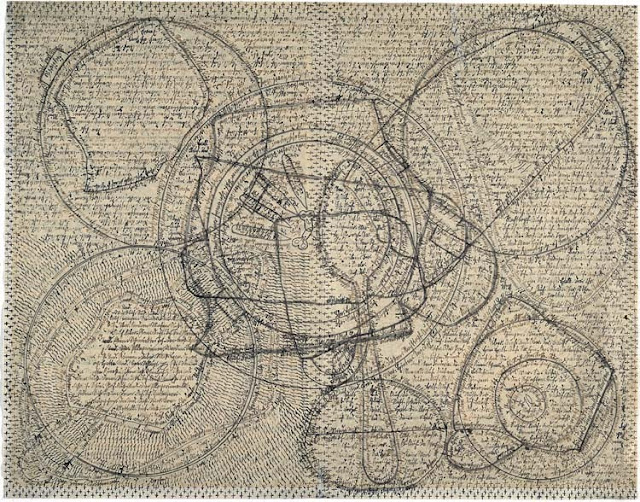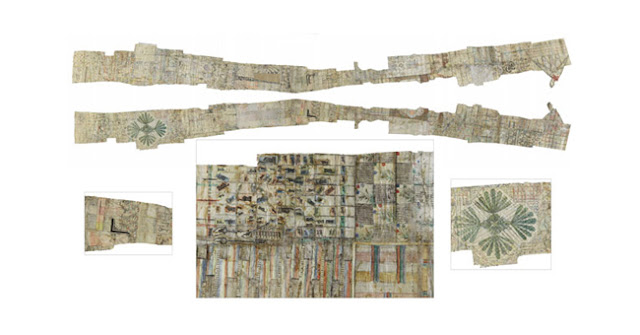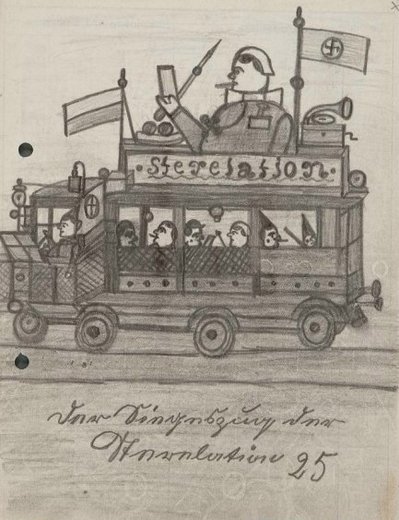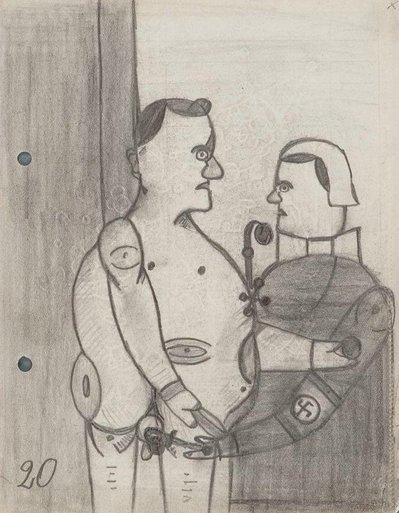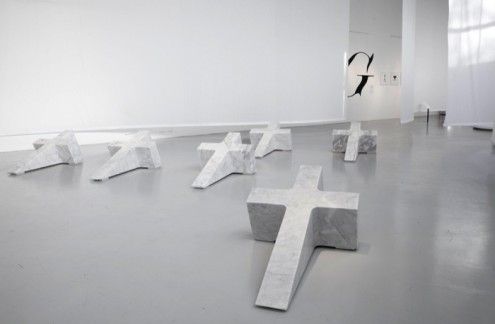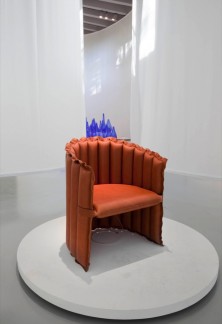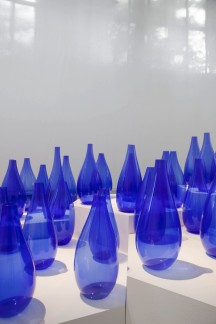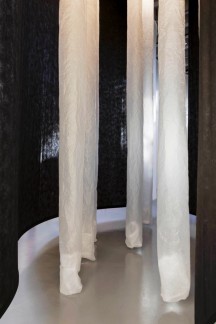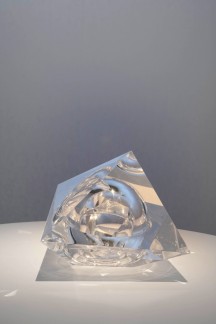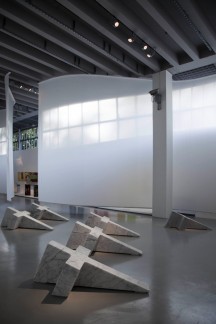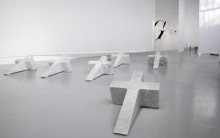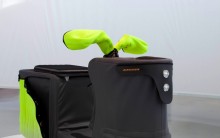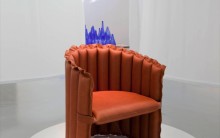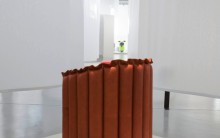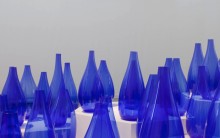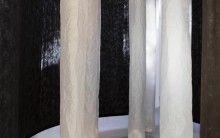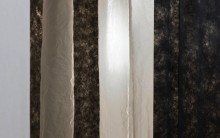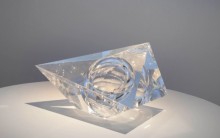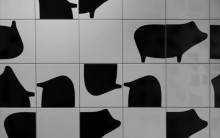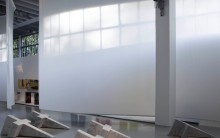((...An important artistic event of 2011 in Athens Greece , is the exhibition of the famous collection Prinzhorn, from the University Psychiatric Clinic in Heidelberg, with works of art accompanied by avery heavy past, as mentally ill artists who painted, were victims of euthanasia program in psychiatric hospitals, of the Third Reich....))
The success of the Surrealist Movement reinforced a tendency which had already begun to manifest itself during the earliest period of Modernism. The work of untrained artists was privileged, and sometimes even perceived as being in important respects superior to that of those who had received a full professional training. This tendency had already manifested itself during the first decade of the Modern Movement. Henri Rousseau, le Douanier (1844-1910), had become well-known amongst the artists of the Parisian avant-garde. His work was celebrated by Alfred Jarry (1873-1907), author of the outrageous farce Ubu Roi (1896), which foreshadows aspects of surrealism itself , and he exhibited in the Salon d’Automne of 1905, the launching pad of the Fauves. The artists of the Blaue Reiter, and the Russian avant-garde groupings of the same period, had shown intense interest in various manifestations of folk-art, and the Blaue Reiter had, in addition, interested itself in the drawings made by children.
The surrealists, fascinated by the workings of the unconscious mind, were especially interested by the artworks produced by the mentally ill. Their fascination had a long history behind it. Artistic creativity and madness had long been associated In the minds of philosophers and scientists. Plato, for example, was disturbed by the fact that poetry did not seem to be the product of reason, and attributed poetic creation to divine possession which was akin to madness: ‘Everyone knows that when a poet is composing he is not in his senses.’[i] Even before the rise of Romanticism, madness and genius were associated, as in Dryden’s often-quoted lines from Absalom and Achitophel (1680):
Great Wits are sure to Madness near alli’d And thin Partitions do their Bounds divide.
In the later part of the nineteenth century, researchers like Cesare Lombroso (1835-1909) tried to create a theory which would associate madness and creative genius according to the latest tenets of scientific materialism. In 1864 Lombroso published the first edition of an enormously influential book L’Uomo do Genio (originally entitled Genio e Follia). This appeared in French in 1889, in English in 1891 and in German in 1894. The main thesis of this was that artistic creativity was the product of hereditary madness.
Lombroso also interested himself in the art produced by hospitalised mental patients who could not necessarily be regarded as geniuses, and he was one of the first to collect drawings and other artworks made by these patients. On the basis of this collection, Lombroso tried to isolate and classify the distinguishing characteristics which were to be found in the art of the insane. One of these characteristics, he found, was ‘originality’. By this he meant not only the use of strange and often totally inappropriate materials (a trait which was often the product of the conditions in which the patients were confined), but the strangeness of the artistic conception itself.
Lombroso’s own aesthetic criteria derive from nineteenth century academic art - he was no friend to the first stirrings of Modernism - and he does not suggest that the artistic products of the mental patients he studies are in any way superior to the work of professional artists. He does, however, note certain traits which were significant for the way in which such work was to be rated in the future. One was the fact that many patients produced apparently abstract or non-representational designs - in which, nevertheless, one could find concealed representations. Another was a marked atavism - a resemblance to ‘primitive’ styles of art which, in turn, for Lombroso, were the reflection of a generically primitive state of mind -something which could be linked to his established theory of mental degeneration.
A third trait noted by Lombroso was the frequent sexual references made in many of the artworks made by mental patients. He discusses these with uncommon frankness for his epoch, though he interprets them as evidence of moral as well as mental collapse.
Modernism, and the surrealists in particular, did not invent the idea that artistic creativity was somehow allied to madness. Nor were the modernists the first to study the art of the mentally ill. They simply changed the perspective in which these things were seen, and as a result, and perhaps without originally meaning to do so, redefined the role of the artist in society.
One of the defining events in this respect was the discovery of certain ‘insane’ artists whose work seemed to rise so far above the level of the rest that they could plausibly be defined as masters. What the Douanier Rousseau did for the reputation untutored painters in general, the Swiss Adolf Wölfli (1864-1930) did for schizophrenics. Wölfli first came to public attention in 1921, thanks to a book written by Dr Walter Morgenthaler (1882-1965), the psychiatrist who had been in charge of the hospital where he was a patient .
Morgenthaler’s study, Ein eisteskranker als Künstler (A Mental Patient as Artist), was
inspired by the conviction that Wölfli was not merely an interesting case study but a true creator. In addition to this, he felt that ‘the mentally ill, from whom the veneer of convention has fallen away, would provide one with an opportunity to see deeper into the structure of humanness, and to penetrate the psyche more deeply , than would be possible with healthy people.’[ii]
Wölfli was born at Nüchtern, near Bern. After the death of his mother, when he was nine, he was brought up by a series of foster parents who mistreated him and used him as a farm labourer. He received little schooling. After making a number of sexual assaults on young girls, he was imprisoned in 1890, at the age of twenty-six. In 1895 he re-offended and as sent to Waldau. During his first years at the hospital he was violent and dangerous both to other patients and to the hospital staff. As a result he had to be isolated. At this time he experienced both visual and auditory hallucinations. In 1899, at the end of the acute phase of his illness, which had lasted for almost five years, he spontaneously began to draw and write.
These images and writings hold up the mirror to a vast delusional system, with Wölfli himself at the centre:
The majority of Wölfli’s pictures show historical events, illustrations of his own life story. Some of them touch on actual events, as when he depicts his trial, or his assaults on young girls. Others are fantasy elaborations of his life experience in terms of epic journeys through the universe; the discovery of new cities, and planets; his meetings and marriages with gods; and scenes of sexual intercourse, and of punishment in which he undergoes repeated execution. In such scenes he appears in his celestial guise as St. Adolph II, the name he adopted after 1916. At the centre of this mythology is the theme of destruction and rebirth. Wölfli is repeatedly killed, executed or destroyed as a result of catastrophic falls.[iii]
Given its own intrinsic fascination, and the moment at which Morgenthaler happened to publish - just as Dada was beginning to give way to the first stirrings of what was to become the Surrealist Movement - the First Surrealist Manifesto was published in Paris in 1924 - it is not surprising that Wölfli achieved a status hitherto accorded to no other insane artist.
In the year after Morgenthaler’s book, there appeared another, even more influential publication. This was Bildnerei des Geistekranken by Dr. Hans Prinzhorn (1886-1933).
 |
| Dr. Hans Prinzhorn |
Rather than being based on the work of one artist, this dealt with the work of a broad spectrum. Prinzhorn was a psychiatrist, working at the Heidelberg Psychiatric Clinic. He had, however, previously trained as an art historian, obtaining a doctorate in art history from Vienna University in 1908, before serving as a doctor in the German army during the war, then moving to Heidelberg in 1919.
When he arrived at Heidelberg, he found that the clinic had already formed a small collection of patient art. Prinzhorn began to research this at the instigation of the director of the Institute, Dr. Karl Willmanns. He was also given time and money to search for new material. By the time he left Heidelberg, shortly before the publication of his book, it amounted to more than 5000 pictures and sculptures by around five hundred artists, covering a period from c. 1890 to c. 1920. The book was enormously successful, and made Prinzhorn famous overnight.
One reason for its success was its timeliness. The leading German Expressionists of the pre-war years had constantly flirted with the idea of madness, and the disturbed post-war climate (especially disturbed in the defeated and chaotic Germany of the early 1920s) seemed to justify their insights. Prinzhorn’s approach to his material was based on that of the great German art historians and aestheticians of the nineteenth century, particularly on that of Heinrich Wölfflin (1864-1945), but was also heavily influenced by the artistic climate of his own time.For example, he saw how Wölfflin’s doctrine of ‘intuitive forms’, themselves the result of ‘prefigurations’, could be extended to this new range of material. He saw art as being primarily a means of externalising the self, and, unlike previous students of patient art, was prepared to find a complete continuity between the images produced by the mentally incapacitated and the work of ‘professional’ artists. In fact, he wanted to make his study of the art of the insane the foundation for a general theory of art. One tool he used was a comparison with the art of primitive societies, which he used to explain the psychological origin of the human ‘need for symbols’.
Prinzhorn’s researches proved to be of great interest to artists connected with the Bauhaus, the radical new art school founded in 1919. Paul Klee saw Prinzhorn’s material very soon after the latter arrived at the Heidelberg Institute, and later kept a copy of Bildnerei des Geisteskranken in his studio. He, in turn, recommended the collection Prinzhorn was making to Oskar Schlemmer (1888-1843), who was to become another important figure in the Bauhaus. Schlemmer recorded his own reactions as follows:
For a whole day I imagined I was going to go mad, and was even pleased at the thought, because then I would have everything I have been wanting; I would exist totally in a world of ideas, of introspection - what the mystics seek.
The Doctor [Prinzhorn] also displayed a drawing with the caption: “Dangerous to look at!” This keeps going through my mind. The drawing showed delicate symbolic signs for love, life, childhood, humour, systematically arranged. Of course the whole business is used as an indictment of modern artists: see, they paint just like the insane! But that is not so, despite the similarity; the madman lives in the realm of ideas which the sane artist tries to reach; for the madman it is purer, because completely separate from external reality. [iv]
Another artist who expressed enthusiasm for the Prinzhorn Collection was a former member of the Blaue Reiter, Alfred Kubin, who in 1922 made a special journey to Heidelberg with a companion in order to inspect the material at first hand:
The works, in themselves [he wrote later]...affected me, and my art-loving friend, immensely strongly, through their hidden adherence to formal order. We were standing before miracles of the artistic spirit, which are summoned up from the depths, free of any intellectual overlay; the creation and contemplation of which must give happiness.[v]
German artists of a younger generation were equally fascinated by material of this sort. As a student of psychiatry at the University of Bonn, in the years before World War I, Max Ernst discovered a rather similar collection to that formed by Prinzhorn in the possession of a local mental hospital:
Near Bonn there was a group of gloomy buildings which in many respects resembled the Hospital of St. Anne in Paris. At this clinic for the mentally ill, students could attend courses and obtain practical experience. In one of these buildings there was an astonishing collection of sculpture and pictures which the unwilling inhabitants of this frightful place had made, most particularly, figures made from breadcrumbs. They touched the young man very deeply and he sought to understand these flashes of genius, and to enquire into the vague and perilous territory on the borders of insanity. Only much later was he to discover certain techniques which enabled him to advance into this no-man’s land.[vi]
The clinic Ernst refers to still exists, but all trace of this apparently remarkable collection has now disappeared.
In 1919, just as Prinzhorn arrived in Heidelberg, Ernst was responsible for the inclusion of work by psychotic artists in the Cologne Dada exhibition of that year.
Ernst thought of writing his own book on the art of the mentally ill, but abandoned the project on the appearance of Prinzhorn’s study. It seems to have been he - a native German speaker - who introduced Prinzhorn’s work to the surrealist circle in Paris. Some of his own later surrealistic works show direct borrowings from art made by the psychotic artists included in the Prinzhorn Collection, such as August Natterer and the sculptor Karl Brendel. The influence was far from temporary. Ernst was still making these borrowings in the early 1960s.
The upsurge of interest in the art of the insane which took place at the beginning of the interwar period had several different effects. In the first place, it confirmed the prejudices of artistic conservatives, which wished to dismiss the achievements of the whole of the Modern Movement as the product of madness. The notorious Degenerate Art Exhibition of 1937, staged in Munich by the Nazis, was founded on the premise that modernist works were the productions of the incurably insane. In one room, Expressionist art works were actually juxtaposed with pictures done by psychotic individuals, and the catalogued reproduced two drawings by Oskar Kokoschka (1886-1980) on the same page as one done by the inmate of an asylum, and challenged the reader to decide which was which. The exhibition included from loans from the Prinzhorn Collection.
It also had an altogether different effect. It was responsible for validating other kinds of work by untrained artists - often those who production was in some way obsessive. Thus the Palais Idéal of Ferdinand Cheval and the Watts Towers built by Simon Rodia in Los Angeles were co-opted into the modernist pantheon, and in due course exercised an influence over the birth of environmental art.
Very few of the artists thus co-opted were in any way sophisticated. One of the rare exceptions was Antonin Artaud (1896-1948), who attached himself to the Surrealist Group in Paris at its official inception in 1924. Artaud’s primary form of activity was theatrical production. Under surrealist auspices, he was the inventor of a new form of drama, the ‘Theatre of Cruelty’. Always bizarre and eccentric in behaviour, he was eventually confined to the first of a series of mental asylums in 1939. During his first two years of confinement he was almost completely autistic. After this, he broke his silence, chiefly in a series of remarkable letters written to friends in Paris, many of them surrealists. He also - as in a previous period of mental illness, which lasted from 1918-20 - began to make drawings, many of them self-portraits related to his own identification with Vincent Van Gogh, while others were related to his sexual and religious delusions. Artaud was released from confinement in 1946, in time to see the great Van Gogh retrospective held in Paris in the following year. The essay he wrote recording his reactions to the exhibition presents his subject (and by implication himself) as revelatory voice of sanity in a society which has gone mad. He extended this accusatory concept to the idea of insanity in general:
What is an authentic madman? It is a man who preferred to become mad, in the socially accepted sense of the word, rather than forfeit a certain superior idea of human honour. So society has strangled in its asylums all those it wanted to get rid of or protect itself from, because they refused to become its accomplices in certain great nastinesses. For a madman is also a man whom society did not want to hear and whom it prevented from uttering certain intolerable truths.[vii]
Madness here becomes, not simply an alternative, but actually a superior truth to the truths of the ‘normal’ world.
The overall result of the attention given to psychotic art was to undermine the established hierarchies of artistic value, in a much more thorough and far-reaching way than had been envisaged by the original pioneers of Modernism. Ever since the birth of the Romantic Movement western art had placed great stress on the idea of originality. More and more, artists were forbidden to rely on the achievements of their predecessors. Each generation of creator, indeed each individual creator, was expected to re-invent the whole idea of art. Psychotic artists were clearly not innovative technicians. Indeed, the vast majority of them were totally untrained in all the accepted processes used for making works of art. From being a crippling defect, this position outside the whole technical tradition of western art was seen as a liberating factor, something which set them free to express the visionary impulse in its purest form. Artists now wanted to follow in the footsteps of these disadvantaged amateur creators: the inner truth expressed by the artwork became its paramount reason for coming into existence. All other reasons were secondary to this.
A true visionary art is without hierarchies, since how can one vision be profitably compared or even related to another? The solipsism of the new art increasingly tended to break down all pre-established aesthetic relationships, and to put in their place the search for an ‘authenticity’ which could never in the end be objectively established.
[i] Plato, The Laws, 4.719, trans. R.G. Bury, London 1955
[ii] Walter Morgenthaler, Aus Meinem Leben, Bern 1960, p. 17.
[iii] John M. MacGregor, The Discovery of the Art of the Insane, Princeton University Press, Princeton N.J. 1989, pp. 212-3.
[iv] Tut Schlemmer ed., The Letters and Diaries of Oskar Schlemmer, Middletown, Conn., 1972, pp.83-4.
[v] Alfred Kubin, Aus Meiner Werkstatt, Munich 1973, p.14.
[vi] Max Ernst, “An Informal Life of M. E., as told by himself to a young friend)”, in Max Ernst, ed. William S. Lieberman, New York 1961 p.9.
[vii] Antonin Artaud, Antonin Artaud: Selected Writings, translated by Helen Weaver, New York 1976, p. 485.

